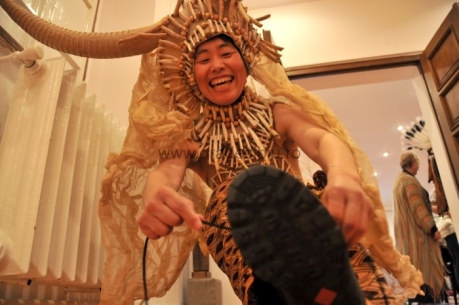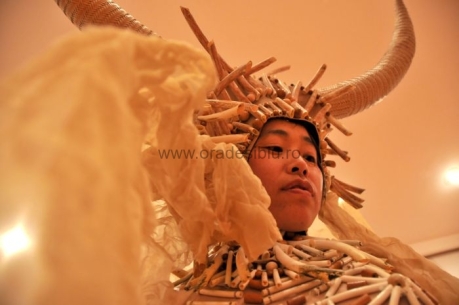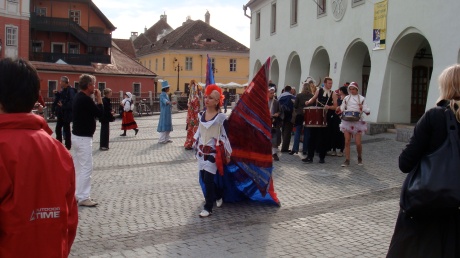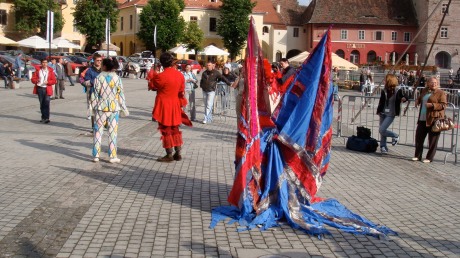Lets work on some scenography basic theory. I found some great links on design, the best ones are so remote that one is lucky to just open it. I’ll just focus on the best one. Enjoy 🙂
The Elements of Visual Design
All visual aspects of a production are composed from the same basic elements: line, shape, space, color, texture and ornament.
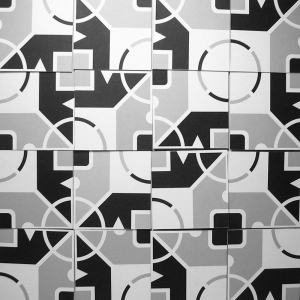
Line defines boundaries and permits us to perceive shape and form. There are two kinds of line—straight and curved—but these may be combined to form zigzags, scallops, and many other variations. The dominant lines of the performance space (with the scenery in place but without performers) are horizontal (the floor and any overhead masking) and vertical (the upright scenic units). This basic pattern is varied by the addition of furniture, ramps, steps, and platforms. In performance, other lines are created by movement and by the placement of the actors in relation to each other and to the scenic elements. The costumes worn by the actors have their own lines created by the silhouette of garments and by darts, seams, ornamentation, and other features that result in visible lines.

Line is often said to evoke identifiable responses: straight lines, stability; curved lines, grace; zigzags, confusion. Therefore, line may be manipulated to achieve desired effects. In scenery, two lines that move farther apart as they rise vertically may generate a feeling of openness, whereas lines that lean in as they rise may generate a feeling of oppression. Line is important in creating mood and atmosphere as well as in defining shape.
 Shape and space are closely related and are frequently treated together as a single element: mass. Whereas line has only direction or length, mass involves three dimensions. It identifies shape (square, round, oblong, and so on) and space (height, width, and thickness). The stage may be thought of as a hollow cube that can be organized or altered in a variety of ways. Scenery may outline or limit the space. So may light, the actors’ movement, or the seating around a thrust or arena stage. Like line, shape and space may be used to affect audience response. An effect of compression may be achieved through the use of thick, horizontal forms overhead (such as a low ceiling with thick beams), whereas a sense of openness and grace may be achieved through the use of narrow~ vertical, and pointed forms (such as thin, tall columns and high Gothic arches). Mass is also reflected in the overall shape of costumes and furniture, the space they occupy, and the way a director groups or isolates actors. Perhaps the most effective means of revealing, concealing, or altering apparent mass is Lighting, which through its direction and intensity can create or eliminate those contrasts of light and shadow that let us perceive shape and dimension.
Shape and space are closely related and are frequently treated together as a single element: mass. Whereas line has only direction or length, mass involves three dimensions. It identifies shape (square, round, oblong, and so on) and space (height, width, and thickness). The stage may be thought of as a hollow cube that can be organized or altered in a variety of ways. Scenery may outline or limit the space. So may light, the actors’ movement, or the seating around a thrust or arena stage. Like line, shape and space may be used to affect audience response. An effect of compression may be achieved through the use of thick, horizontal forms overhead (such as a low ceiling with thick beams), whereas a sense of openness and grace may be achieved through the use of narrow~ vertical, and pointed forms (such as thin, tall columns and high Gothic arches). Mass is also reflected in the overall shape of costumes and furniture, the space they occupy, and the way a director groups or isolates actors. Perhaps the most effective means of revealing, concealing, or altering apparent mass is Lighting, which through its direction and intensity can create or eliminate those contrasts of light and shadow that let us perceive shape and dimension.
 Color may be described in terms of three basic properties: hue, saturation or intensity, and value. Hue is the attribute that allows us to identify a color (red, green, blue, and so on). Saturation or intensity refers to the relative purity of a color (its freedom from its complementary or opposite hue). Value is the lightness or darkness of a color— its relation to white or black. A color that is light in value is usually called a tint; one dark in value is called a shade. Hues are classified as primary secondary, or intermediate. The primary hues are those that cannot be created by mixing other hues but from which all other hues are derived. The primary hues in pigment are yellow, red, and blue. The secondary hues—orange, violet, and green—are created from equal mixtures of two primary hues. The intermediate hues are mixtures of a primary with a secondary hue. Hues may be arranged around a wheel to indicate their relationships. (See the color wheel, plate 14.) Those opposite each other on the wheel are called complementary those next to each other, analogous. The primary hues are equidistant from each other on the wheel. Hues may further be described as warm or cool. Red, orange, and yellow are warm; green, blue, and violet are cool. Almost any combination of hues may be used together if saturation, proportion, and value are properly controlled.
Color may be described in terms of three basic properties: hue, saturation or intensity, and value. Hue is the attribute that allows us to identify a color (red, green, blue, and so on). Saturation or intensity refers to the relative purity of a color (its freedom from its complementary or opposite hue). Value is the lightness or darkness of a color— its relation to white or black. A color that is light in value is usually called a tint; one dark in value is called a shade. Hues are classified as primary secondary, or intermediate. The primary hues are those that cannot be created by mixing other hues but from which all other hues are derived. The primary hues in pigment are yellow, red, and blue. The secondary hues—orange, violet, and green—are created from equal mixtures of two primary hues. The intermediate hues are mixtures of a primary with a secondary hue. Hues may be arranged around a wheel to indicate their relationships. (See the color wheel, plate 14.) Those opposite each other on the wheel are called complementary those next to each other, analogous. The primary hues are equidistant from each other on the wheel. Hues may further be described as warm or cool. Red, orange, and yellow are warm; green, blue, and violet are cool. Almost any combination of hues may be used together if saturation, proportion, and value are properly controlled.
Mood and atmosphere depend much on color. Many people believe that light, warm colors are more suitable to comedy than are dark, cool colors. Some color combinations are considered garish, others sophisticated. Designers may manipulate color to create the appropriate mood and atmosphere and to establish the tastes of the characters that inhabit the settings or wear the costumes. Color can suggest the relationship among characters (either sympathetic or antipathetic) through the colors of their garments. Color can be used to make some characters stand out and others fade into the background (for example, Hamlet wears mourning black in the midst of others dressed in colors of rejoicing). As with mass, lighting is one of the most important means of controlling color, because it can enhance, distort, or reduce apparent color in scenery, costumes, makeup, and all the other elements.
Texture may help to elicit the desired response trough such qualities as smoothness, roughness, shininess, softness, or graininess. Some plays seem to demand rough textures, others smooth. Such qualities as sleaziness, fragility or richness depend much on the texture (actual or simulated) of settings, costumes, and (by analogy) acting.
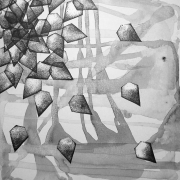
Ornament includes the paintings, decorative motifs, wallpaper patterns, moldings, and similar details of settings. His one of the chief means of achieving distinctiveness. In costume, ornament includes ruffles, buttons, fringe, and lace. Ornament can be used to indicate taste or the lack of it. Too much ornamentation or too many kinds of ornamentation may indicate lack of restraint or impart a sense of clutter. Accessories, such as canes, swords, purses, and jewelry may also be considered ornaments. In acting gesture and stage business (the amount and complexity and its relative simplicity or fussiness) serve much the same function as ornament in visual design.
http://classnotes47.tripod.com/theater/theatertest3a.htm
June 16, 2009
Categories: Arta, Desen, design, Design Theory, Scenografie, scenography, Theater, Theatre . Tags: alina nicoleta, design, scenography, Theater, Theatre, theory . Author: alina_nicoleta . Comments: 1 Comment


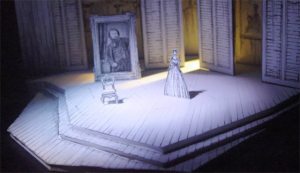
 Scenic design visually characterizes the acting space. Just how it does so depends on the production concept. If the concept demands that locales be represented realistically, the designer will probably select architectural details, furniture, and decorations that clearly indicate a specific period and locale. For example, the designer might create a setting fix A Doll’s House that suggests a room in a Norwegian house around 1880. Another production concept might demand fragmentary settings with only enough pieces to establish the general character of the locale. Another might rely largely on visual motifs and theatrical conventions from the era when the play was written. A setting for Tartuffe, for example, might use decorative motifs and a wing-and-drop setting reflecting the age of Louis XIV. Or, as has become increasingly common, the concept may demand that the time and place of the action be altered (such as Hamlet being translated to an American Mafia context).
Scenic design visually characterizes the acting space. Just how it does so depends on the production concept. If the concept demands that locales be represented realistically, the designer will probably select architectural details, furniture, and decorations that clearly indicate a specific period and locale. For example, the designer might create a setting fix A Doll’s House that suggests a room in a Norwegian house around 1880. Another production concept might demand fragmentary settings with only enough pieces to establish the general character of the locale. Another might rely largely on visual motifs and theatrical conventions from the era when the play was written. A setting for Tartuffe, for example, might use decorative motifs and a wing-and-drop setting reflecting the age of Louis XIV. Or, as has become increasingly common, the concept may demand that the time and place of the action be altered (such as Hamlet being translated to an American Mafia context). Another way of characterizing the space is to treat it as flexible and nonspecific, a common practice for plays with actions divided into many scenes and set in many places, as is typical in most of Shakespeare’s plays. To represent each place realistically would require a large number of sets as wet1 as a great deal of time to change them, thereby interrupting the continuity, rhythm, and flow of the action. On the other hand, to play all of the scenes on the flat floor of an undecorated stage might become monotonous. A common solution is an arrangement of platforms, steps, and ramps that breaks up the stage space, that provides several acting areas that can be localized as needed through the addition of a few well-chosen properties, pieces of furniture, banners, images projected on screens, or through other means.
Another way of characterizing the space is to treat it as flexible and nonspecific, a common practice for plays with actions divided into many scenes and set in many places, as is typical in most of Shakespeare’s plays. To represent each place realistically would require a large number of sets as wet1 as a great deal of time to change them, thereby interrupting the continuity, rhythm, and flow of the action. On the other hand, to play all of the scenes on the flat floor of an undecorated stage might become monotonous. A common solution is an arrangement of platforms, steps, and ramps that breaks up the stage space, that provides several acting areas that can be localized as needed through the addition of a few well-chosen properties, pieces of furniture, banners, images projected on screens, or through other means.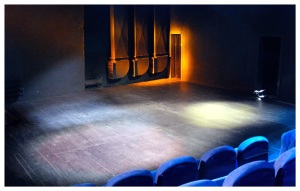


 Shape and space are closely related and are frequently treated together as a single element: mass. Whereas line has only direction or length, mass involves three dimensions. It identifies shape (square, round, oblong, and so on) and space (height, width, and thickness). The stage may be thought of as a hollow cube that can be organized or altered in a variety of ways. Scenery may outline or limit the space. So may light, the actors’ movement, or the seating around a thrust or arena stage. Like line, shape and space may be used to affect audience response. An effect of compression may be achieved through the use of thick, horizontal forms overhead (such as a low ceiling with thick beams), whereas a sense of openness and grace may be achieved through the use of narrow~ vertical, and pointed forms (such as thin, tall columns and high Gothic arches). Mass is also reflected in the overall shape of costumes and furniture, the space they occupy, and the way a director groups or isolates actors. Perhaps the most effective means of revealing, concealing, or altering apparent mass is Lighting, which through its direction and intensity can create or eliminate those contrasts of light and shadow that let us perceive shape and dimension.
Shape and space are closely related and are frequently treated together as a single element: mass. Whereas line has only direction or length, mass involves three dimensions. It identifies shape (square, round, oblong, and so on) and space (height, width, and thickness). The stage may be thought of as a hollow cube that can be organized or altered in a variety of ways. Scenery may outline or limit the space. So may light, the actors’ movement, or the seating around a thrust or arena stage. Like line, shape and space may be used to affect audience response. An effect of compression may be achieved through the use of thick, horizontal forms overhead (such as a low ceiling with thick beams), whereas a sense of openness and grace may be achieved through the use of narrow~ vertical, and pointed forms (such as thin, tall columns and high Gothic arches). Mass is also reflected in the overall shape of costumes and furniture, the space they occupy, and the way a director groups or isolates actors. Perhaps the most effective means of revealing, concealing, or altering apparent mass is Lighting, which through its direction and intensity can create or eliminate those contrasts of light and shadow that let us perceive shape and dimension. Color may be described in terms of three basic properties: hue, saturation or intensity, and value. Hue is the attribute that allows us to identify a color (red, green, blue, and so on). Saturation or intensity refers to the relative purity of a color (its freedom from its complementary or opposite hue). Value is the lightness or darkness of a color— its relation to white or black. A color that is light in value is usually called a tint; one dark in value is called a shade. Hues are classified as primary secondary, or intermediate. The primary hues are those that cannot be created by mixing other hues but from which all other hues are derived. The primary hues in pigment are yellow, red, and blue. The secondary hues—orange, violet, and green—are created from equal mixtures of two primary hues. The intermediate hues are mixtures of a primary with a secondary hue. Hues may be arranged around a wheel to indicate their relationships. (See the color wheel, plate 14.) Those opposite each other on the wheel are called complementary those next to each other, analogous. The primary hues are equidistant from each other on the wheel. Hues may further be described as warm or cool. Red, orange, and yellow are warm; green, blue, and violet are cool. Almost any combination of hues may be used together if saturation, proportion, and value are properly controlled.
Color may be described in terms of three basic properties: hue, saturation or intensity, and value. Hue is the attribute that allows us to identify a color (red, green, blue, and so on). Saturation or intensity refers to the relative purity of a color (its freedom from its complementary or opposite hue). Value is the lightness or darkness of a color— its relation to white or black. A color that is light in value is usually called a tint; one dark in value is called a shade. Hues are classified as primary secondary, or intermediate. The primary hues are those that cannot be created by mixing other hues but from which all other hues are derived. The primary hues in pigment are yellow, red, and blue. The secondary hues—orange, violet, and green—are created from equal mixtures of two primary hues. The intermediate hues are mixtures of a primary with a secondary hue. Hues may be arranged around a wheel to indicate their relationships. (See the color wheel, plate 14.) Those opposite each other on the wheel are called complementary those next to each other, analogous. The primary hues are equidistant from each other on the wheel. Hues may further be described as warm or cool. Red, orange, and yellow are warm; green, blue, and violet are cool. Almost any combination of hues may be used together if saturation, proportion, and value are properly controlled.
